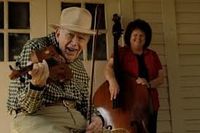Annotation:Josie-O: Difference between revisions
No edit summary |
Alan Snyder (talk | contribs) m (Fix HTML) |
||
| Line 3: | Line 3: | ||
<p><font face="garamond, serif" size="4"> | <p><font face="garamond, serif" size="4"> | ||
'''JOSIE-O'''. AKA - "[[Josie Girl]]." Old-Time, Breakdown. G Major. Standard tuning (fiddle). AABBCC. A tune from the repertoire of Art Stamper (as "Josie-O"), and Charlie Acuff (b. 1919, who learned it from his grandfather, Charlie Boyd Acuff, as "Josie Girl"). A 'josie' is a type of cape with an attached outer cover. The ditty sung to the tune (in the second half of the first strain, and the first half of the second strain) go: | '''JOSIE-O'''. AKA - "[[Josie Girl]]." Old-Time, Breakdown. G Major. Standard tuning (fiddle). AABBCC. A tune from the repertoire of Art Stamper (as "Josie-O"), and Charlie Acuff (b. 1919, who learned it from his grandfather, Charlie Boyd Acuff, as "Josie Girl"). A 'josie' is a type of cape with an attached outer cover. The ditty sung to the tune (in the second half of the first strain, and the first half of the second strain) go: | ||
<blockquote> | </font></p> | ||
<blockquote><font face="garamond, serif" size="4"><i> | |||
''Where’s that girl, where’s she gone,''<br> | ''Where’s that girl, where’s she gone,''<br> | ||
''Where’s the girl with the josie on?''<br> | ''Where’s the girl with the josie on?''<br> | ||
| Line 9: | Line 10: | ||
''Stole my heart, away she’s gone,''<br> | ''Stole my heart, away she’s gone,''<br> | ||
''Where’s the girl with the josie on?''<br> | ''Where’s the girl with the josie on?''<br> | ||
</blockquote> | </i></font></blockquote> | ||
<p><font face="garamond, serif" size="4"> | |||
"[[Barlow Knife (1)]]" is a related melody. | "[[Barlow Knife (1)]]" is a related melody. | ||
<br> | |||
<br> | |||
</font></p> | </font></p> | ||
[[File:acuff.jpg|200px|thumb|right|Charlie Acuff]] | |||
<p><font face="garamond, serif" size="4"> | <p><font face="garamond, serif" size="4"> | ||
''Source for notated version'': Charlie Acuff (Tennessee) [Milliner & Koken]. | ''Source for notated version'': Charlie Acuff (Tennessee) [Milliner & Koken]. | ||
<br> | <br> | ||
| Line 24: | Line 28: | ||
</font></p> | </font></p> | ||
<p><font face="garamond, serif" size="4"> | <p><font face="garamond, serif" size="4"> | ||
''Recorded sources'': <font color=teal>Cleff'd Ear CD TFS 114, Charlie Acuff | ''Recorded sources'': | ||
<font color=teal> | |||
Cleff'd Ear CD TFS 114, Charlie Acuff – "Better Times A Comin'" (2000). | |||
County CO-CD-2729, Art Stamper – "Goodbye Girls, I'm Going to Boston" (2000). | |||
</font> | |||
<br> | <br> | ||
<br> | <br> | ||
| Line 35: | Line 43: | ||
</font></p> | </font></p> | ||
<br> | <br> | ||
<br> | <br style="clear:both"/> | ||
---- | ---- | ||
'''Back to [[{{BASEPAGENAME}}]]''' | '''Back to [[{{BASEPAGENAME}}]]''' | ||
Revision as of 23:02, 28 December 2016
Back to Josie-O
JOSIE-O. AKA - "Josie Girl." Old-Time, Breakdown. G Major. Standard tuning (fiddle). AABBCC. A tune from the repertoire of Art Stamper (as "Josie-O"), and Charlie Acuff (b. 1919, who learned it from his grandfather, Charlie Boyd Acuff, as "Josie Girl"). A 'josie' is a type of cape with an attached outer cover. The ditty sung to the tune (in the second half of the first strain, and the first half of the second strain) go:
Where’s that girl, where’s she gone,
Where’s the girl with the josie on?
Stole my heart, away she’s gone,
Where’s the girl with the josie on?
"Barlow Knife (1)" is a related melody.

Source for notated version: Charlie Acuff (Tennessee) [Milliner & Koken].
Printed sources: Milliner & Koken (Milliner-Koken Collection of American Fiddle Tunes), 2011; p. 350.
Recorded sources:
Cleff'd Ear CD TFS 114, Charlie Acuff – "Better Times A Comin'" (2000).
County CO-CD-2729, Art Stamper – "Goodbye Girls, I'm Going to Boston" (2000).
Sea also listing at:
Hear Charlie Acuff play "Josie Girl" [1]
See a 1998 clip of Charlie Acuff playing the tune [2]
Jane Keefer's Folk Music Index: An Index to Recorded Sources [3]
Back to Josie-O
